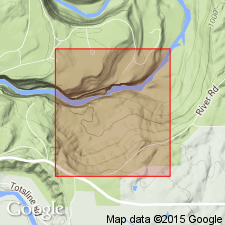
- Usage in publication:
-
- Portage or Upper Fucoidal group
- Modifications:
-
- Original reference
- Dominant lithology:
-
- Sandstone
- Shale
- AAPG geologic province:
-
- Appalachian basin
Summary:
Pg. 391-392, 452-455. Portage or Upper Fucoidal group. Underlies Chemung group and overlies Gardeau or Lower Fucoidal group. Consists of (descending): (1) slightly argillaceous, compact, and finer-grained sandstone than No. 2, 150 to 200 feet; in places contains some pyrites; (2) shales and sandstones; (3) coarse-grained sandstone forming platform or table rock of lower falls of Genesee River. The sandstones do not have the glazing of shale, as do those of underlying Gardeau or Lower Fucoidal group. [Age is Late Devonian.]
Source: US geologic names lexicon (USGS Bull. 896, p. 1702-1704).
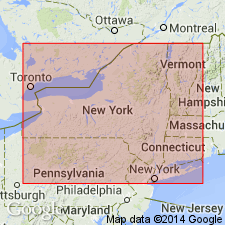
- Usage in publication:
-
- Portage or Nunda group
- Modifications:
-
- Revised
- AAPG geologic province:
-
- Appalachian basin
Summary:
Pg. 172. Portage or Nunda group. Includes Cashaqua shale, Gardeau and Portage groups, and Sherburne flagstone and shale of reports. Underlies Ithaca group and overlies Genesee slate. [Age is Late Devonian.]
Source: US geologic names lexicon (USGS Bull. 896, p. 1702-1704).
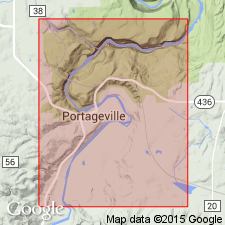
- Usage in publication:
-
- Portage or Nunda group
- Modifications:
-
- Principal reference
- Revised
- Dominant lithology:
-
- Shale
- AAPG geologic province:
-
- Appalachian basin
Summary:
Pg. 224-249. Portage or Nunda group. Includes Sherburne flagstones and shale, Cashaqua shale, Gardeau and Portage groups of annual reports. Named for superior development along banks of Genesee River in district formerly included in town of Nunda, now Portage. Overlies Genesee slate and underlies Chemung group (in which Ithaca shale is included, because of its fossils). Thickness not less than 1,000 feet. Divided into (descending) Portage sandstones (the thick-bedded sandstones at Portage), Gardeau shale and flagstones, and Cashaqua shale. [Age is Late Devonian.]
Source: US geologic names lexicon (USGS Bull. 896, p. 1702-1704).
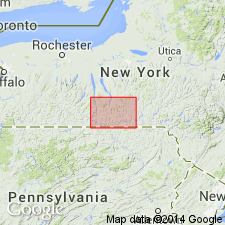
- Usage in publication:
-
- Portage formation
- Modifications:
-
- Revised
- AAPG geologic province:
-
- Appalachian basin
Summary:
Following the Genesee, and conformable with it, are beds of Portage formation. In this are included those beds which have been generally referred to by term Portage, or Portage group. Portage group was originally defined by Hall (1840) and applied to sandstones lying above Gardeau flagstone of Genesee Valley and distinct from the Gardeau, Ithaca, and Cashaqua groups which were named in same report. In this folio [Watkins Glen-Catatonk], rocks between the Genesee and Chemung are called Portage formation. Portage formation, which in typical region of Genesee Valley is composed of the Cashaqua, Gardeau, and "Portage" members, consists in Watkins Glen quadrangle of (ascending) Sherburne, Ithaca, and Enfield members. [Age is Late Devonian.]
[See also entry under Wilmarth.]
Source: US geologic names lexicon (USGS Bull. 1200, p. 3099-3100).

- Usage in publication:
-
- Portage group
- Portage formation
- Modifications:
-
- Overview
- AAPG geologic province:
-
- Appalachian basin
Summary:
In 1885 (New York State Geol. Rpt. for 1884, p. 9-22, and USGS Bull. 16) J.M. Clarke included "Portage sandstones" in Chemung group, because of their contained fauna. He also described Portage or Nunda group of Hall as containing, in Ontario County, in lower part, an "Upper Black Band" 6 to 10 feet thick and a "Lower Black Band" 40 feet thick, the two separated by 150 feet of greenish and drab soft shales, the "Lower Black Band" being underlain by 10 to 15 feet of soft olive-green and grayish shales resting on Genesee beds. The "Lower Black Band" was later named Middlesex shale. According to D.D. Luther, 1899 (New York State Geol. 16th Ann. Rpt., for 1896), the black shale, 30 to 40 feet thick, that "has sometimes been called the Lower Black Band of the Portage Group" belongs in Genesee shale. (In 1904, however, Luther and Clarke included this bed in the Portage.) In 1888 C.S. Prosser and H.S. Williams classified the Portage rocks as consisting of Upper Portage sandstones and shales, 600 feet; Middle Portage or Ithaca, 450 feet; and Lower Portage sandstones and shales, 250 feet. In 1893 Prosser (GSA Bull., v. 4, p. 116-117) applied Portage to rocks between the Chemung and Genesee, and assigned to them thicknesses of 900 to 1,000 feet in western New York, 1,300 to 1,780 feet in western-central New York, and 1,315 feet in eastern New York. In 1894 James Hall applied Portage to the rocks between Genesee and chemung. The same year J.M. Clarke described Upper Portage as = the [so-called] Portage sandstones, the Middle Portage as = Ithaca, and the Lower Portage as resting on the Genesee. In 1897 James Hall continued to include in top of Portage group the "mass of heavy bedded sandstones which were originally termed 'Portage sandstones.' " The same year (also in 1899) J.M. Clarke included in top of the Portage not only the †Portage sandstone but the overlying Wiscoy shales and flags, and defined the Portage base as top of Genesee shale. In 1898 and 1899 F.J.H. Merrill divided Portage group into Portage sandstone, Naples beds, Gardeau shale and sandstone and Cashaqua shale; and D.D. Luther also used Portage in two senses, i.e., for the group and for top formation of the group. In 1901 and 1902 Luther called the group Portage or Nunda, included in it the Wiscoy shales at top, and applied Portage sandstones to the sandstones underlying the Wiscoy. J.M. Clarke's 1903 Hdb. included in Portage group the Wiscoy shale, "Portage sandstones," and underlying beds to base of Middlesex shale. In 1903 H.F. Cleland (USGS Bull. 206), also J.M. Clarke and D.D. Luther (New York State Mus. Bulls., 63 and 82), applied Portage to the beds between the Ithaca and the Genesee. In 1906 and 1907 (Jour. Geol., vols. 14 and 15) H.S. Williams used Nunda formation to include the beds between Chemung and Genesee, the name Portage "having been dropped because it was already specifically applied to the upper sandstone member of Nunda formation of Genesee Valley." In 1908 (New York State Mus. Bull. 118) J.M. Clarke and D.D. Luther introduced Nunda sandstone for the sandstones that had previously been called Portage sandstones, and stated that paleontologically the Wiscoy shales and sands belong to Portage group, although they were not included in original (1840) definition of Portage group. In 1909 (USGS Watkins Glen-Catatonk folio, no. 169) H.S. Williams defined Portage formation of typical Chemung area as underlying Cayuta member of the Chemung, overlying Genesee shale, and as divided into (descending) Enfield member, Ithaca member, and Sherburne member. In 1912 C.A. Hartnagel (New York State Mus. Hdb. 19, p. 74) defined Portage formation of western New York as consisting of beds carrying the Naples fauna; in central New York of the Sherburne and Ithaca beds partially intercalated with the Naples fauna; in eastern New York of the Sherburne and Ithaca beds (marine) overlain by the Oneonta beds (brackish). And he included in the Portage all beds between top of Wiscoy shale and base of Middlesex shale. In 1913 H.S. Williams (USGS Prof. Paper 79) defined Portage formation of central New York as underlying Cayuta shale member of Chemung formation, as resting on Genesee shale, and as divided into Enfield shale member (top), Ithaca shale member, and Sherburne flagstone member (base); and described Oneonta sandstone of eastern New York as = upper part of Ithaca shale member. He also stated that to east the Chemung type of sediments began earlier and occupy the time interval of Enfield shale and upper part of Ithaca shale. In 1920 (GSA Bull., v. 31, p. 118) G.H. Chadwick included in the Portage all beds between base of Middlesex shale and top of Nunda sandstone. In 1923 (GSA Bull., v. 34, p. 69) and 1924 (New York State Mus. Bull. 251, p. 149-157) he transferred to the Chemung of western New York certain beds (Dunkirk shale, Gowanda shale, Laona sandstone, Westfield shale, Shumla sandstone, and Northeast shale) that had previously been included in the Portage, and drew base of Chemung at top of Hanover shale of western New York and at top of Wiscoy shale of west-central New York. (See his correlations under Chemung formation, 1924 entry.)
Source: US geologic names lexicon (USGS Bull. 896, p. 1702-1704).
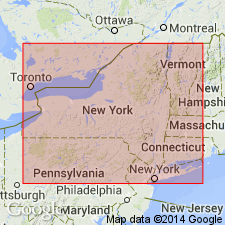
- Usage in publication:
-
- Portage group
- Modifications:
-
- Revised
- AAPG geologic province:
-
- Appalachian basin
Summary:
Pg. 369. Divided Portage group of western New York into (descending) Wiscoy shale, Nunda sandstone, Gardeau shale, Grimes sandstone, Hatch shale, Rhinestreet shale, Cashaqua shale, Middlesex Shale, Standish shale, West River shale, and Genundewa limestone, and restricted the Genesee to the basal member (the Geneseo shale of Chadwick). [Age is Late Devonian.]
Source: US geologic names lexicon (USGS Bull. 896, p. 1702-1704).

- Usage in publication:
-
- Portage group
- Modifications:
-
- Revised
- AAPG geologic province:
-
- Appalachian basin
Summary:
Pg. 165-180 and I.W. Fox, 1932 (AAPG Bull., v. 16, no. 7, p. 676-690). Expanded Portage group by including in it, at base, West River formation and Genundewa limestone, both formerly included in the Genesee, which they restricted to the basal part of the Genesee of common usage, or to the beds named Geneseo shale by Chadwick in 1920. [Age is Late Devonian.]
Source: US geologic names lexicon (USGS Bull. 896, p. 1702-1704).
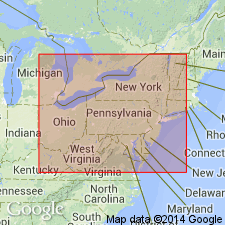
- Usage in publication:
-
- Portage bluestones
- Modifications:
-
- Revised
- AAPG geologic province:
-
- Appalachian basin
Summary:
(No. 2, p. 91-107, Sept. 1933.) Pg. 96-100. Adopted Portage for the bluestone and Nunda for the group. [Age is Late Devonian.]
Source: US geologic names lexicon (USGS Bull. 896, p. 1702-1704).
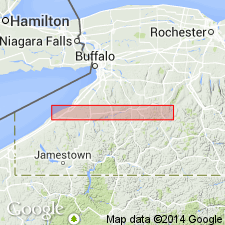
- Usage in publication:
-
- Portage group†
- Portage bluestones
- Modifications:
-
- Revised
- AAPG geologic province:
-
- Appalachian basin
Summary:
Pg. 319. All the upper and major part of what has long passed as "Portage group" (correctly Nunda) is = type Chemung, although wholly different in facies. [On p. 345 he stated:] Along Genesee River, at and below Portageville, is type section of what has currently passed as Portage, i.e., all beds from Genesee group up to include Portage sandstones (bluestone), to which it seems historically necessary to limit the name, and above these the Wiscoy shales. A century of painstaking collecting has failed to disclose throughout this entire "Portage" sequence (along Genesee River) a single fossil of Chemung aspect. In topmost beds (Wiscoy member) on is startled, however, to find a large cup coral, "out of its depth." [On p. 346:} No one in those days [Hall's time] would have been countenanced in supposition Chemung at east and Portage at west are identical. [On p. 352:] The former "Portage" (correctly the Nunda) group, because it bestrides both Naples and Chemung, lacks application beyond its type section along Genesee River. Historically, Portage either applied to the bluestones or is replaced by the uncontroversial synonym High Point, for Nunda, having been used first in group sense, has no rights of restricted applications to these bluestones in way Clarke employed it over protests of H.S. Williams. [On this p. 352 Chadwick correlated Wellsburg sandstone member of type Chemung with (descending) Hanover shale, Pipe Creek black shale, and Portage bluestones, and correlated the underlying Cayuta member of type Chemung with (descending) Letchworth shale (new), Gardeau shale, and Grimes sandstone.]
Source: US geologic names lexicon (USGS Bull. 896, p. 1702-1704).

- Usage in publication:
-
- Portage sandstone†
- Portage group
- Modifications:
-
- Overview
- AAPG geologic province:
-
- Appalachian basin
Summary:
The USGS in 1906 (after correspondence with interested American geologists) discarded Portage sandstone and adopted Portage group, to include the rocks below Cayuta shale member of Chemung and above Genesee shale, or the same definition then employed by New York State Survey. In central Pennsylvania the Portage group has been divided into Brallier shale above and Harrell shale below and includes at top beds equivalent to Wiscoy shale of New York. The Middlesex shale is recognized as basal bed of the Portage of New York. B. Willard, 1935 (Pennsylvania Acad. Sci. Proc., v. 9, p. 40), divided Portage group of Pennsylvania into (descending) Trimmers Rock ("Ithaca") sandstone, Brallier greenish shale, Harrell dark gray shale, Burket ("Genesee") black shale, and Tully limestone. Age is Late Devonian.
Source: US geologic names lexicon (USGS Bull. 896, p. 1702-1704).
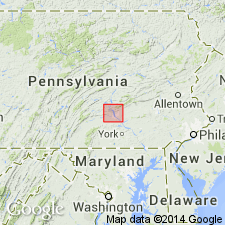
- Usage in publication:
-
- Portage group
- Modifications:
-
- Revised
- AAPG geologic province:
-
- Appalachian basin
Summary:
Pg. 13-16. Upper Devonian begins with lowest beds of Portage group which in Juniata Valley are represented by remnant of Tully. This rests disconformably upon highest Hamilton, the Moscow shale, with its VITULINA zone. Top of Portage group lies approximately at base of Catskill red beds, of early Chemung age. Divisions of Portage recognized in Pennsylvania are (ascending) Rush formation (with Tully shale and limestone and Burket black shale) and Fort Littleton formation (with Harrell gray shale, Brallier sandstone and shale, Losh Run shale, Trimmers Rock sandstone, and Parkhead sandstone). Changes among members of group occur from Allegheny Front into eastern Pennsylvania. In the west, members are all shale except Tully and group is dominated by Brallier shale. From Susquehanna Valley east, dominant element of group is Trimmers Rock sandstone which has largely displaced Brallier shale. Tully is little known east of Susquehanna and is presumably displaced by Burket black shale.
Source: US geologic names lexicon (USGS Bull. 1200, p. 3099-3100).
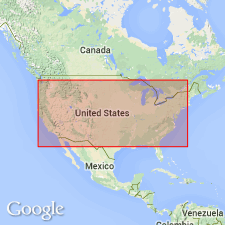
- Usage in publication:
-
- "Portage" formation
- Portage shale
- Modifications:
-
- Areal extent
- AAPG geologic province:
-
- Appalachian basin
Summary:
On Devonian correlation chart term "Portage" formation is used in colunm for east-central West Virginia. Portage shale is used in column for Genesee Valley, Portage is shown above the Letchworth and below the Wiscoy.
Source: US geologic names lexicon (USGS Bull. 1200, p. 3099-3100).
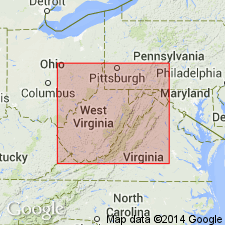
- Usage in publication:
-
- "Portage" shale
- Modifications:
-
- Not used
- AAPG geologic province:
-
- Appalachian basin
Summary:
Pg. 385. Term Brallier shale replaces "Portage" shale as formerly used in West Virginia.
Source: US geologic names lexicon (USGS Bull. 1200, p. 3099-3100).
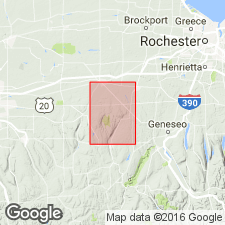
- Usage in publication:
-
- Portage group
- Portage formation
- Modifications:
-
- Not used
- AAPG geologic province:
-
- Appalachian basin
Summary:
Pg. 392-396. Four formations, Grimes sandstone, Gardeau flags and shales, Nunda sandstone, and Wiscoy shale, overlie Naples group in Batavia quadrangle. No group name is applied to them, although they belong to the Chemung stage. They had previously been included in Portage group but Chadwick (1933, Pan-Amer. Geol., v. 60) returned name Portage to formational status.
Source: US geologic names lexicon (USGS Bull. 1200, p. 3099-3100).
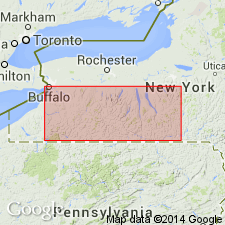
- Usage in publication:
-
- Portage formation
- Modifications:
-
- Not used
- AAPG geologic province:
-
- Appalachian basin
Summary:
Pg. 2821, 2826. Report presents revised correlations of lower Upper Devonian rocks in western and central New York. Sherburne flagstone member is excluded from Portage formation of Williams (1906, Sci., n.s., v. 24) and Williams and others (1909) and assigned to Genesee formation. Ithaca shale member of Portage is redefined as Ithaca member of Genesee. In area south of Cayuga Lake, the Sonyea formation occupies the upper four-fifths of rock sequence that was designated Enfield shale member of Portage by Williams and others (1909).
Source: US geologic names lexicon (USGS Bull. 1200, p. 3099-3100).

- Usage in publication:
-
- "Portage" beds
- Modifications:
-
- Areal extent
- AAPG geologic province:
-
- Appalachian basin
Summary:
Unit mapped as marine beds (Dm) consists of gray to olive-brown shales, graywackes, and sandstones; contains "Chemung" beds and "Portage" beds including Burket, Brallier, Harrell, and Trimmers Rock; Tully limestone at base.
Source: US geologic names lexicon (USGS Bull. 1200, p. 3099-3100).
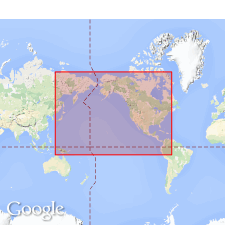
- Usage in publication:
-
- Portage Group†
- Portage Formation†
- Portage Shale†
- Modifications:
-
- Abandoned
- AAPG geologic province:
-
- Appalachian basin
Summary:
In 1843, Hall redefined "Portage or Nunda" Group to include older rocks, specifically Sherburne Flagstones, Cashaqua Shale, the Gardeau and Portage Groups of the annual reports. As redefined, Hall's Portage comprises all of the West Falls Formation, all of the Sonyea Formation, and upper two-thirds of Genesee Formation of de Witt and Colton (1959).
Source: US geologic names lexicon (USGS Bull. 1200, p. 3099-3100).
For more information, please contact Nancy Stamm, Geologic Names Committee Secretary.
Asterisk (*) indicates published by U.S. Geological Survey authors.
"No current usage" (†) implies that a name has been abandoned or has fallen into disuse. Former usage and, if known, replacement name given in parentheses ( ).
Slash (/) indicates name conflicts with nomenclatural guidelines (CSN, 1933; ACSN, 1961, 1970; NACSN, 1983, 2005, 2021). May be explained within brackets ([ ]).

